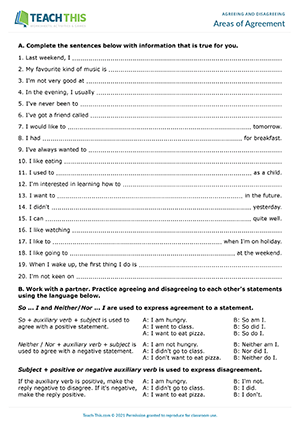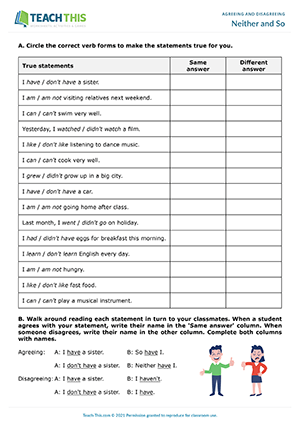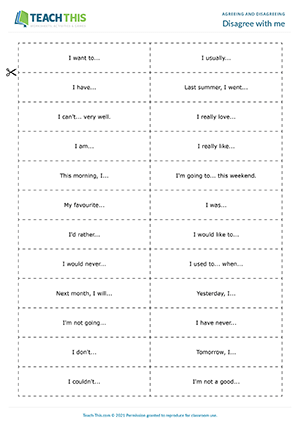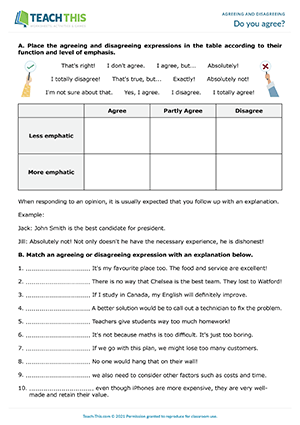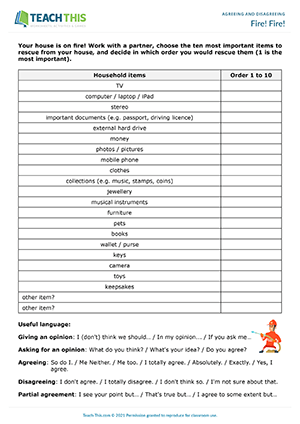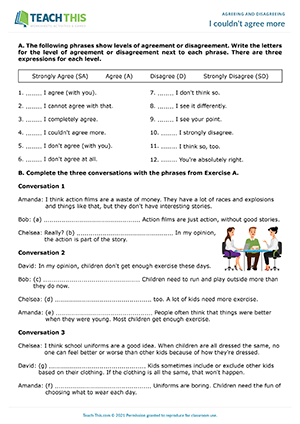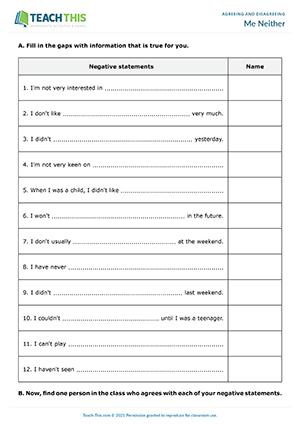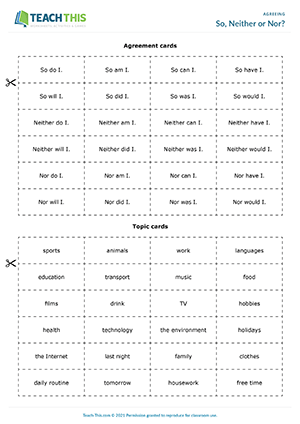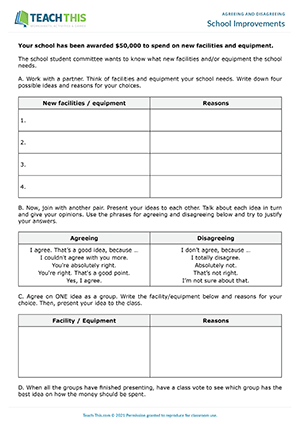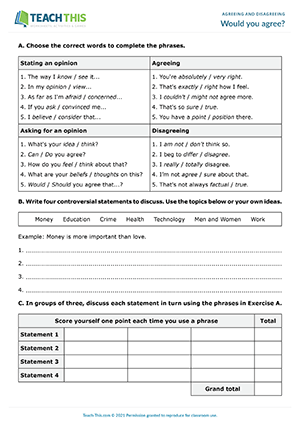Agreeing and Disagreeing ESL Activities, Games and Worksheets
This engaging agreeing and disagreeing speaking activity helps to teach students how to agree and disagree with positive and negative statements with so, neither or nor. Students begin by completing positive and negative statements on the worksheet with true information. Next, in pairs, one student goes first and reads their statements to their partner, e.g. 'Last weekend, I went to the park'. Their partner listens and reacts by agreeing or disagreeing with each statement, paying attention to whether the statement is positive or negative, e.g. 'So did I'. When the student has read out all their statements, they swap roles. Finally, pairs report back to the class on the things they agreed on.
In this communicative neither and so speaking activity, students agree and disagree with positive and negative statements using neither and so. Students begin by circling one of the verb forms in each statement on their worksheet to make each statement true for them. Students then walk around reading each statement in turn, trying to find someone who agrees with their answer and someone who disagrees. When the students have finished, they share some of their results with the class.
Here is an amusing agreeing and disagreeing game to help students practice expressions of agreement and disagreement. In groups, students take it in turns to select one of their cards and complete the statement on the card with true information. The student's task is to say something that no one else will agree with. The other group members then respond by agreeing or disagreeing with the statement. If no one agrees with the statement, the student wins the card. If someone agrees, then the card is removed from the game. The student with the most cards at the end of the game is the winner.
In this comprehensive agreeing and disagreeing worksheet, students learn and practice phrases for agreeing and disagreeing with opinions. To start, students categorise agreeing and disagreeing phrases according to their function and level of emphasis. Students then match the agreeing and disagreeing expressions with explanations. Next, students agree or disagree with opinions using the expressions and follow up with an explanation to support each response. After that, in pairs, students take it in turns to read each opinion and practice agreeing or disagreeing using their responses. Finally, in pairs, students take turns giving an opinion on the topics provided and responding with a suitable expression followed by an explanation.
In this productive agreeing and disagreeing speaking activity, students discuss which items to save in a house fire. In pairs, students imagine that they share a house which contains all the items on the worksheet. Their house is on fire, and they have a few minutes to save as many possessions as possible. In pairs, students then give their opinions and reach an agreement on which ten items to choose and in which order to rescue them using the language on the worksheet. Students are also encouraged to justify their opinions and give reasons. When everyone has finished, pairs read out their results and the class discusses the findings.
In this useful agreeing and disagreeing worksheet, students practice 12 phrases that show various levels of agreement or disagreement. Students start by identifying the level of agreement or disagreement in 12 phrases by writing strongly agree, agree, disagree or strongly disagree next to each expression. Students then do a gap-fill exercise where they complete three conversations with the phrases. Next, students say whether they agree or disagree with a set of statements by writing sentences about their opinions that include the phrases to agree or disagree. In the last exercise, students work with a partner and practice agreeing or disagreeing with the opinions from the exercises in the worksheet.
This communicative neither and nor speaking activity helps students to practice agreeing with negative statements using neither and nor. First, students complete negative statements on the worksheet with information that is true for them. Students then go around the classroom reading their statements to one another, trying to find one person in the class who agrees with each of their negative statements. When a student agrees with a classmate’s statement, the student agreeing responds with an appropriate expression, e.g. 'Neither am I'. The other student then writes down their name. If the student doesn’t agree with the statement, they respond by saying what they have written for the same prompt. At the end of the activity, students tell the class what they found out.
In this entertaining agreeing game, students race to agree with statements using so, neither or nor. In groups, students take it in turns to turn over a topic card and show it to the group, e.g. sports. The student then picks up a set of agreement cards and looks at the phrase on the first card, e.g. 'So do I'. Next, the student tries to make one of the other students say the phrase on the card by making a statement related to the topic, e.g. 'I sometimes play football in the park'. The first student to agree with the statement using the correct phrase wins and keeps the card. The student then looks at the next agreement card and phrase and makes another statement relating to the topic, trying to get through as many so, neither or nor cards as possible in one minute. When the time limit has been reached, students count up their agreement cards, scoring a point for each one. The student with the most points at the end of the game wins.
Here is a fun agreeing and disagreeing role-play activity to help students practice language for expressing agreement, disagreement and surprise. Students pretend that an opinion on a card is their own. Students then find a partner and tell them their opinion. Their partner reacts with an expression of agreement, disagreement or surprise from the board and asks a follow-up question to keep the conversation going. Afterwards, students swap roles. When they have finished, students exchange cards and find a new partner. The process is then repeated. After ten minutes, students turn over their opinion card and write an opinion of their own on the blank side of the card. The activity is then repeated with students using their own opinions.
In this communicative agreeing and disagreeing speaking activity, students agree and disagree on how money should be spent on school facilities and equipment. Students pretend that their school has been awarded $50,000 to spend on new facilities and equipment. The students' task is to put forward ideas on what new facilities or equipment to get with the money. In pairs, students think of facilities and equipment their school needs and writes down four possible ideas and reasons. Next, each pair joins up with another pair. Pairs then present each idea to each other and give their opinions, agreeing and disagreeing. The two pairs then agree on one idea as a group and present it to the class who votes for the best one.
This free agreeing and disagreeing speaking activity helps students to practice various phrases for stating an opinion, asking for an opinion, agreeing and disagreeing. First, students choose the correct words to complete phrases for stating an opinion, asking for an opinion, agreeing and disagreeing. Students then write four controversial statements using the topics on the worksheet. Next, in groups, students discuss each statement for two minutes using the phrases from the worksheet. The aim is to try to use as many of the phrases as possible during each discussion. Each time a student says one of the phrases, they score a point and put a tick in the table on their worksheet. The student with the most points after all the statements have been discussed wins.



